Angiosperms:
Flowering Plants
Background Information
Like the gymnosperms, the angiosperms are adapted for life in
a drier environment (although some are secondarily aquatic). Unlike
gymnosperms, the seeds of the angiosperms form within an ovary on the adult
plant: fruit is a ripened/mature ovary.

Monocot and Dicot Sprouts
Division
Angiospermae
is sometimes called Division Anthophyta (anthe = flower;
phyto = plant) because the common name for this group is the
“flowering plants.” Angiosperms are so named because the seeds are enclosed
within a fruit of some sort.
Division Angiospermae contains two main classes:
Class Monocotyledones
(the “monocots”) and
Class Dicotyledones
(the “dicots”).
These two classes can be distinguished in a number of ways (summarized, here,
but more information is included in the table, below).
The seeds of the Monocotyledoneae (mono = one) contain one
cotyledon (one nutrient-storage area — think of a kernel of corn),
while those of the Dicotyledoneae (di = two) contain two cotyledons
(think of the two “halves” of a bean or peanut).
There are other differences between monocots and dicots. In general,
monocot leaves are parallel-veined while dicot leaves are net-veined.
Monocots generally have flower parts in groups of three or multiples of
three while dicots have flower parts in fours, fives, or occasionally twos
(or multiples thereof). There are also differences between the two in the
arrangement of the vascular bundles (xylem and phloem) in both the roots
and stems.
In plants, in general, xylem carries water up from the
roots while phloem carries sugar, etc. around (down) the plant, In
general, xylem is to the top of vascular bundles within a leaf and to the
center of vascular bundles within a stem, with respect to the phloem.
Examine, draw and label,
and take notes on any available materials as indicated in the protocol.
| Monocots |
Dicots |
| Seeds |
|---|
| Number of Cotyledons |
|---|
| one nutrient storage area (cotyledon) |
two nutrient storage areas (cotyledons) |
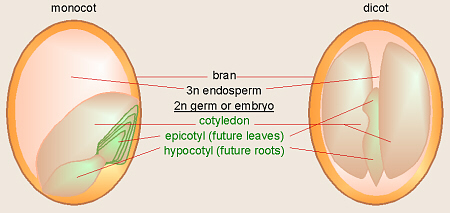 |
|
The embryo (the new sporophyte plant) in the seed consists
of:
- one or two nutrient-storage areas
called cotyledons which are in contact with (and absorb nutrients
from) the 3n endosperm (discussed below). Seeds of some
species store their nutrients primarily in the endosperm, having very small
cotyledon(s), while others have most of their nutrients stored in their
cotyledons and the endosperm is very small.
- the epicotyl (epi =
upon, over), which is the region above the cotyledon(s), and which
will become the stem and leaves,
- the hypocotyl (hypo =
under, beneath), which is the region under the cotyledon(s). The
lower end of the hypocotyl, which becomes the root system, is called the
radicle (radix = root) and will become the roots.
The endosperm in angiosperm seeds
is a result of a rather unusual fertilization. The egg produced by the
female gametophyte is 1n, but it is surrounded by some other tissue (also 1n).
The pollen produces two sperm nuclei. One of these fertilizes the egg,
resulting in a 2n zygote. The other sperm nucleus unites with two
nuclei from the tissue surrounding the egg to form a 3n endosperm.
In some species of seeds, the endosperm is larger while the cotyledon(s)
is/are smaller, but in other seeds, the reverse is true.
|
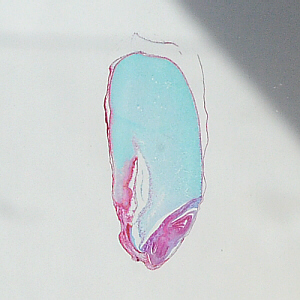
 |
|
|
Examine a monocot seed such as the plastic mount of sprouting corn and
the slide of a
cross section of a Triticum (wheat) seed (wheat berry) (Carolina
#B726 or B726a = 30-5120). A large part of these seeds is endosperm
(endo = within, inner), which stores nutrients for the embryo. These
seeds have only one cotyledon up against the endosperm with a
hypocotyl ending in a radicle and a rather well-developed
epicotyl.
|
Examine the seeds of a dicot such as the plastic mount of a sprouting
bean seed.
Note the two cotyledons (cotyl = cup, socket, cavity)
used to store food for the embryo plant, as well as the hypocotyl
(hypo = under, beneath), terminating in the radicle
(radix = root) which will become the roots. The mound of tissue
between the cotyledons is called the epicotyl (epi = upon,
over, beside) and will become the stem and leaves.
|
| Roots |
|---|
| Roots are generally underground and serve to absorb water and nutrients. |
| Number and Arrangement of Roots |
|---|
many fibrous roots
(think of pulling up a clump of grass) |
one main taproot
(may have smaller roots branching off)
(think of a carrot) |
| Arrangement of Root Vascular Bundles |
|---|
| alternating bundles of xylem and phloem |
xylem forms an “X” in center
with phloem between its arms |
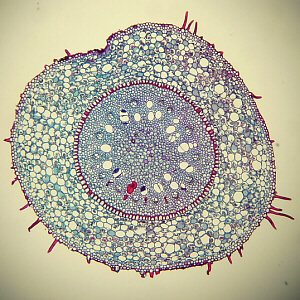 |
 |
Examine the slide with cross sections of a dicot (Ranunculus –
buttercup) root and a monocot (Smilax – greenbrier) root (Carolina
#B518c = 30-1892).
Also, view the giant root models.
|
|
In the monocot root notice the different arrangement of the vascular
tissue within the endodermis. The xylem and phloem cells alternate
around the edges of the central vascular area.
|
In the dicot root, the xylem (xylo = wood) forms a cross
or X in the center with the phloem (phloeo = the bark of
a tree) in between its arms. This vascular bundle is surrounded by a
layer of cells called the endodermis (endo = within,
inner; derm = skin). The outermost layer of cells is the
epidermis, and the region between the endodermis and epidermis
is the cortex made of parenchyma cells (paren =
parent, chym = juice, flavor) which are used to store food.
|
| Leaves |
|---|
| Leaves can be many shapes from round to heart-shaped to oblong.
Leaves can be either simple or compound in form and can
be either alternate, opposite, or whorled
in their arrangement.
Leaves which are entire, all in one piece, are called simple leaves,
while those divided into multiple leaflets are called compound leaves.
Compound leaves with their leaflets arranged like a feather are said to
be pinnately compound (pinna = wing, feather) while leaves
with their leaflets arranged like a person’s fingers are said to be
palmately compound. Leaves that arise from the branch/stem in
pairs are referred to as opposite leaves, while those which
alternate sides up the stem are referred to as alternate leaves,
and if more than two leaves arise from the same spot, those leaves are
said to be whorled.
|
 |
| alternate, simple leaves → |
 |
| alternate, compound leaves → |
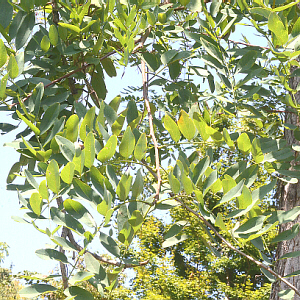 |
| opposite, simple leaves → |
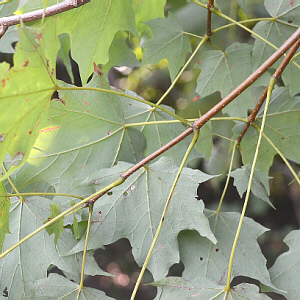 |
| Leaf Vein Direction |
|---|
| parallel veins |
net or branching veins |
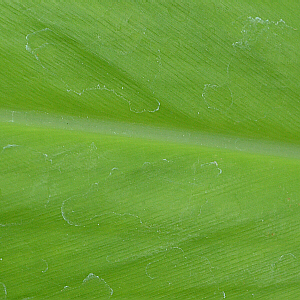 |
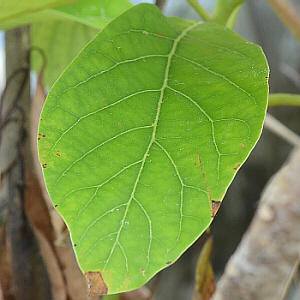 |
| microscopic cross section |
microscopic cross section |
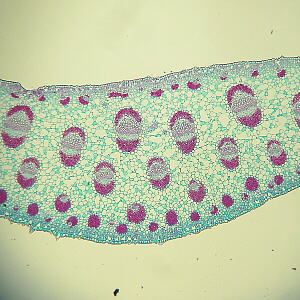 |
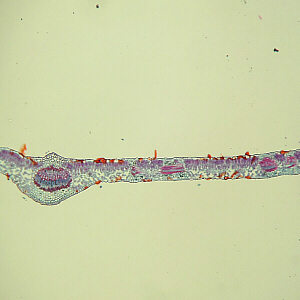 |
| closer view |
closer view |
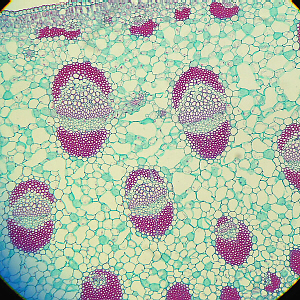 |
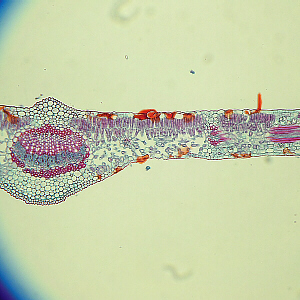 |
|
Examine a cross section of a leaf of yucca, a monocot (Carolina #B666).
In the monocot leaf, notice that all the vascular bundles are visible in
cross section because the leaf is parallel-veined.
|
Examine a cross section of a leaf of pear, a dicot (Carolina #B669 or B669a).
In the dicot leaf, you may see sections of veins cut at various angles
because the leaf is net-veined.
|
Note that both have upper and lower epidermis, a spongy
mesophyll (meso = middle, phyll = leaf) with a layer
of palisade cells along the upper portion, stomates
(stoma = mouth) which are found especially in the lower epidermis,
and vascular bundles. In general, xylem is found in the
“top and center” of vascular bundles. Note that both have a large
vascular bundle in the midrib of the leaf.
Also, examine the giant leaf model.
|
| Fruits |
|---|
| Fruit is a
ripened (mature) ovary (in which seeds develop/are found) and which
serves as protection and means of dispersal for the seeds.
|
| Types of Fruit |
|---|
 Various types of fruits include:
Various types of fruits include:
- Simple fruits arise from one ovary in one flower. Examples include cucumber, squash, peapod, walnut, tomato, orange, cherry, apple, coconut, dandelion, and maple “helicopter.”
There are a number of types of simple fruit, each with its own official name.
- Aggregate fruits arise from several/multiple ovaries in
one flower.
Examples include raspberry and strawberry.
- Multiple fruits arise from ovaries in many,
tightly-clustered flowers which grow/fuse together into one “fruit.”
Examples include pineapple, mulberry, and breadfruit.
|
As time and samples allow, examine and draw the
structure of and/or taste various fruits such as blueberries, cherries,
strawberries, pineapple, coconut, green pepper, corn, squash, peanuts,
etc.
It was mentioned, above, that dicots typically have flower parts in sets
of 4 or 5, and since fruit is a ripened or mature ovary, it would be
logical to expect that, in flowers that have parts in sets of five,
there would also “sets of five” visible in the fruits of those flowers.
Examine an apple and/or starfruit cut in half crosswise to observe the
five chambers of the ovaries.
|
| Flowers |
|---|
| Names and Placement of Flower Parts |
|---|
Flowers are the reproductive structures of an angiosperm and consist of four whorls of modified leaves (from outside in):
- Sepals (sepi = fence in) (which collectively are called the calyx), which are often small and green but are colored like the petals in tulips and lilies, and which generally enclose the flower before it opens
- Petals (petal = a leaf, spread out, flat) (which collectively are called the corolla) which are often brightly colored to attract pollinators (insects, birds, etc.) and may be very simple to highly modified
- Stamens (stam(en) = anything standing upright, a
thread), the “male” reproductive organs (they make microspores
which turn into male gametophytes), which consist of a stalk
(the filament) and a tip (the anther) where the
microspores are produced and turn into pollen (anthe =
flower)
The stamen is the “male” reproductive structure (the microsporophyll), and
the anther is the microsporangium. Microspores are produced and grow into
1n male gametophytes (= pollen) within the anther. Mature gametophytes
are released and transferred to the stigma of the pistil by a pollinator
(wind, insects, birds, etc.), and this process is referred to as
pollination. Each pollen grain grows a pollen tube into the ovary and
its two sperm nuclei travel down the tube to a female gametophyte.
- Pistil (note spelling) or carpel (carpo = a fruit), which consists of:
- Ovary (ova, ovi = egg)
- the bottom end where seeds are produced
- Style (styl, stylo = a pillar, stake, column)
- the “stalk” portion
- Stigma (stigma = spot)
- the outer, sticky tip where pollen sticks when it lands or is placed there
The pistil is the “female” reproductive structure (the megasporophyll),
and the ovary within it is actually the megasporangium. Megaspores are
produced by meiosis, and then form 1n female gametophytes that contain eight
nuclei. Six of these nuclei are in smaller cells at the ends of the
gametophyte, one of which is the actual egg, and two are in a larger cell in
the center.
|
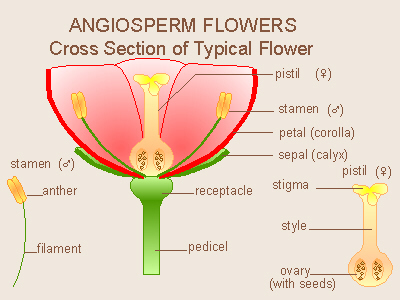 |
|
Examine the giant flower model and locate the outer layer of sepals,
the petals within them, then the stamens, and in the center,
the pistil(s).
|
| Botanists group species of plants
(or, from the other direction, the monocots and dicots can be subdivided)
based on a number of characteristics. Botanists pay particular
attention to how the flowers are put together:
|
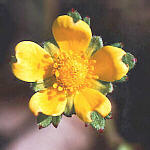 A complete flower has all four layers of parts.
A complete flower has all four layers of parts.
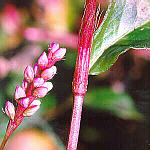 An incomplete flower lacks one or more layers. These knotweed
flowers lack petals (corolla).
An incomplete flower lacks one or more layers. These knotweed
flowers lack petals (corolla).
 A perfect flower had both “sexes” — both stamens and pistil(s). A
monoecious
plant has perfect flowers or has both male and female flowers on the
same plant (for example, Easter lily, pea, dandelion, and rose).
A perfect flower had both “sexes” — both stamens and pistil(s). A
monoecious
plant has perfect flowers or has both male and female flowers on the
same plant (for example, Easter lily, pea, dandelion, and rose).
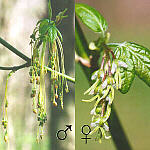 An imperfect flower is lacking either the pistil or stamens. A
dioecious
plant has imperfect flowers on separate male and female plants (for
example, marijuana, hops, persimmon, and boxelder). Note that plants
such as ginkgo, a gymnosperm which doesn’t produce flowers but which
has separate male and female reproductive structures on separate male
and female plants, are also referred to as being dioecious.
An imperfect flower is lacking either the pistil or stamens. A
dioecious
plant has imperfect flowers on separate male and female plants (for
example, marijuana, hops, persimmon, and boxelder). Note that plants
such as ginkgo, a gymnosperm which doesn’t produce flowers but which
has separate male and female reproductive structures on separate male
and female plants, are also referred to as being dioecious.
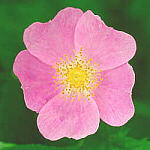 A regular flower is radially symmetrical.
A regular flower is radially symmetrical.
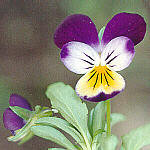 An irregular flower has bilateral symmetry, and is also known as a
zygomorphic
flower.
An irregular flower has bilateral symmetry, and is also known as a
zygomorphic
flower.
|
| Number of Flower Parts |
|---|
| flower parts in 3s or multiples of 3s |
flower parts in 2s, 4s, or 5s |
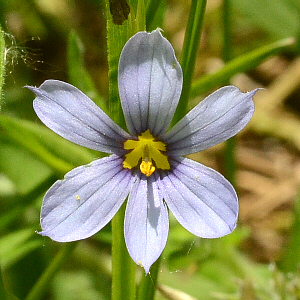 |
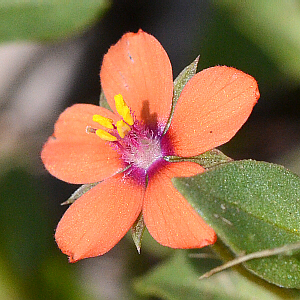 |
 |
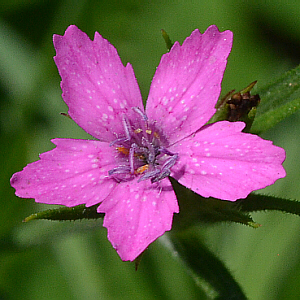 |
 |
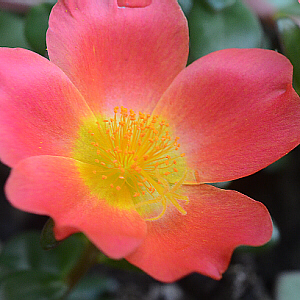 |
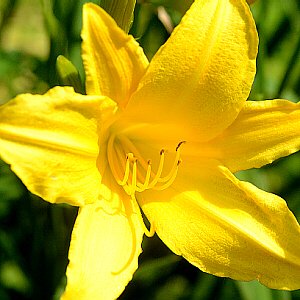 |
 |
| Arrangement of Flowers on the Plant |
|---|
Multiple flowers
can be arranged or clustered in various ways, including:
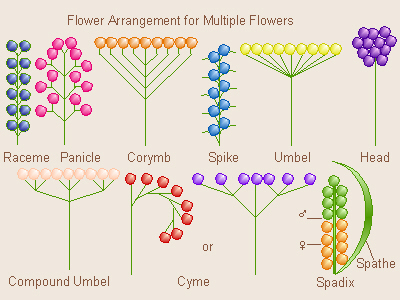
|
|
Observe,
as available, monocot and dicot flowers. Notice that monocots have
flower parts in sets of three while dicots have flower parts in sets of
four or five. Dissect and illustrate a dandelion head and some other
wildflower as follows.
- First, make sure you know how
to use the dissecting scope and dissecting kit.
- If flowers are blooming at this
time of year, take a short field hike to pick two wildflowers. This
must be on a sunny day so the flowers are open. If flowers are not
blooming at this time of year, “florist” flowers will be available.
- a fresh dandelion head
- some other wildflower, not
a composite (Purple Dead-nettle, Yellow Rocket, violet, etc., as
available/blooming)
- Answer these questions for
each of the two flowers (before dissection):
- What is its scientific
name?
- To what family does it
belong (give characteristics of this family)?
- Briefly summarize the
habitat where you found it.
- Dissect out a complete floret
from the dandelion, illustrate as large as you can in a single field
under the dissection scope to show and label:
- ovary
- corolla, petals if
distinguishable
- style
- stigma
- anthers (fused)
- calyx (sepals)
- State which features of the
flower structure indicate relative evolutionary advancement over early
primitive flower structures.
- Dissect and illustrate your
second flower, providing the same information for it.
Here is a
review of
Dandelion Flower Parts.
In addition to materials available during this lab, we will also
be examining flowers as we go on our hikes.
|
| Angiosperm Life Cycle |
|---|
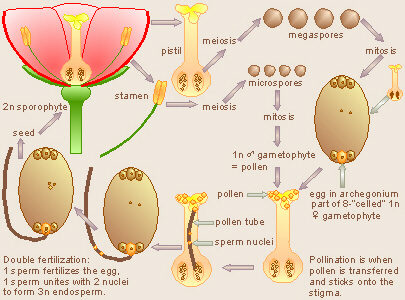 |
Angiosperms have alternation of generations with the 2n
sporophyte being the dominant generation. The anthers, which are the
microsporangia, produce microspores by meiosis, and the microspores develop
into male gametophytes (= pollen).
The ovaries, which are the megasporangia, produce megaspores
which grow into female gametophytes, each of which then produces an egg.
Note that technically the “sex organs” of a plant aren’t
because they produce spores (micro- or mega-) which turn into male or female
gametophytes. The gametophytes bear the true sex organs, such as they are,
and are where eggs or sperm are actually produced.

Honey Bee Pollinator
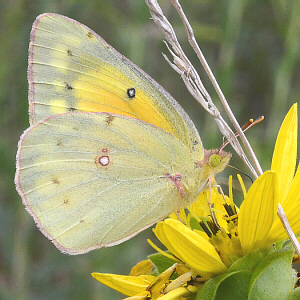
Butterfly Pollinator
By some means (wind or an animal pollinator), the
pollen is transferred to the stigma of the pistil, and a pollen tube grows
down into the ovary. Eventually, two sperm nuclei travel down the pollen
tube. Pollination is the transfer of the male gametophyte (pollen)
to the stigma of the female, while fertilization (which occurs
after pollination is when the sperm nucleus and egg nucleus unite.
Angiosperms have an unusual method called double
fertilization. When the sperm nuclei reach the female gametophyte,
as might be expected, one sperm nucleus and the egg cell’s nucleus unite to
form the new 2n zygote (which grows into an embryo sporophyte, the start of
the new 2n sporophyte generation). Interestingly, however, the other sperm
nucleus and two nuclei in the “center” of the female gametophyte join
to form 3n endosperm tissue. In many seeds, this 3n endosperm serves
as a nutrient storage area (food for the embryo).
In general, monocots tend to store food in their endosperms,
and nutrients
are transferred to the cotyledon only as needed. In contrast, many (not
all) dicots tend to store food in their cotyledons with the endosperm being
reduced to a papery coating around the embryo.
Angiosperm seeds, then, are composed of the new 2n sporophyte
(epicotyl,
cotyledon(s), and hypocotyl) surrounded by or next to 3n endosperm, and
covered by some kind of seed coat made from the old 1n female gametophyte.
The “old” 2n ovary, itself, typically grows into some kind of structure that
aids in
dispersal of the seeds. A ripened or mature ovary is called fruit,
and can be anything from the apples and oranges that we think of as “fruit”
to squash to peanut shells to maple “helicopters” to dandelion
“fluff.”
Characteristics of Some of the “Main” Plant Families
Family
example(s) |
Tree or Herb?
| Type of Leaves
| Type of Flowers
| Fruit and/or Seeds
| Other
|
| Gymnosperms |
Pinaceae
Genus Pinus
pines |
tree |
needles* |
|
pine cone*
(not a fruit) |
|
| Angiosperms |
| Dicots |
Ranunculaceae
buttercups |
herb |
|
5 petals*
many stamens
ovary above |
|
|
Cruciferae
mustard, etc. |
herb |
|
4 petals*
6 stamens |
|
(olive fam. has 4 pet. & 2 stamens) |
Aceraceae
Genus Acer
maple
(boxelder) |
tree |
most simple
opposite* |
|
seed with a wing |
|
Rosaceae
rose
cherry
bramble
apple |
both |
alternate
simple or compound |
5 petals*
many stamens
ovary under |
rose hips
raspberry
strawberry |
|
Leguminosae
pea
bean
locust tree |
both |
compound
alternate |
petals joined so pea flower |
peapod shaped fruit* |
|
Fagaceae
Genus Quercus
oaks |
tree |
simple
alternate |
|
acorn* |
|
Umbelliferae
carrot
dill
Queen Anne’s lace |
herb |
|
many flowers arranged in an umbel* |
seeds like dill or caraway |
|
Labiatae
mints |
herb |
simple
opposite |
some petals joined so irregular |
|
stems are square* |
Compositae
daisy
goldenrod
dandelion |
herb |
|
many flowers arranged in one head* |
|
|
| Monocots |
Gramineae
grasses |
herb |
blades w/ parallel veins |
|
seeds like wheat or corn |
|
Some Related Links:
Other Things to Include in Your Notebook
Make sure you have all of the following in your lab notebook:
- all handout pages (in separate protocol book)
- all notes you take as you read through the Web page and/or
during the introductory mini-lecture
- all notes and data you gather as you perform the lab
- labeled drawings (yours!) of
- angiosperm life cycle diagram
- prepared slide of monocot seed xs
- prepared slide of monocot root xs
- prepared slide of dicot root xs
- prepared slide of monocot stem xs
- prepared slide of dicot stem xs
- prepared slide of monocot leaf xs
- prepared slide of dicot leaf xs
- any fruits that were examined
- cross-section of generic flower
- individual, live dandelion flower
- at least one (preferably more) other, live flower(s)
- any other prepared slides, plastic mounts, models, and/or
live plants that were examined
- answers to all discussion questions, a summary/conclusion in your
own words, and any suggestions you may have
- any returned, graded pop quiz
Copyright © 2011 by J. Stein Carter. All rights reserved.
Based on printed protocols Copyright © 1993 by D. B. Fankhauser
and Copyright © 1989 by J. L. Stein Carter.
Chickadee photograph Copyright © by David B. Fankhauser
This page has been accessed  times since 5 Sep 2011.
times since 5 Sep 2011.







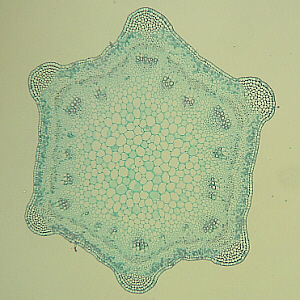
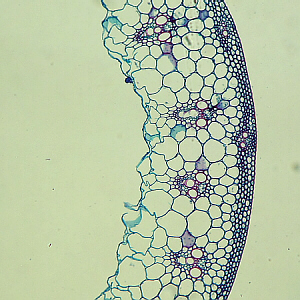

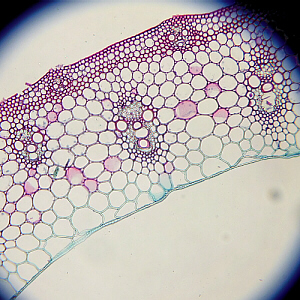










 Various types of fruits include:
Various types of fruits include:

 A complete flower has all four layers of parts.
A complete flower has all four layers of parts.
 An incomplete flower lacks one or more layers. These knotweed
flowers lack petals (corolla).
An incomplete flower lacks one or more layers. These knotweed
flowers lack petals (corolla).
 A perfect flower had both “sexes” — both stamens and pistil(s). A
A perfect flower had both “sexes” — both stamens and pistil(s). A
 An imperfect flower is lacking either the pistil or stamens. A
An imperfect flower is lacking either the pistil or stamens. A
 A regular flower is radially symmetrical.
A regular flower is radially symmetrical.
 An irregular flower has bilateral symmetry, and is also known as a
An irregular flower has bilateral symmetry, and is also known as a











